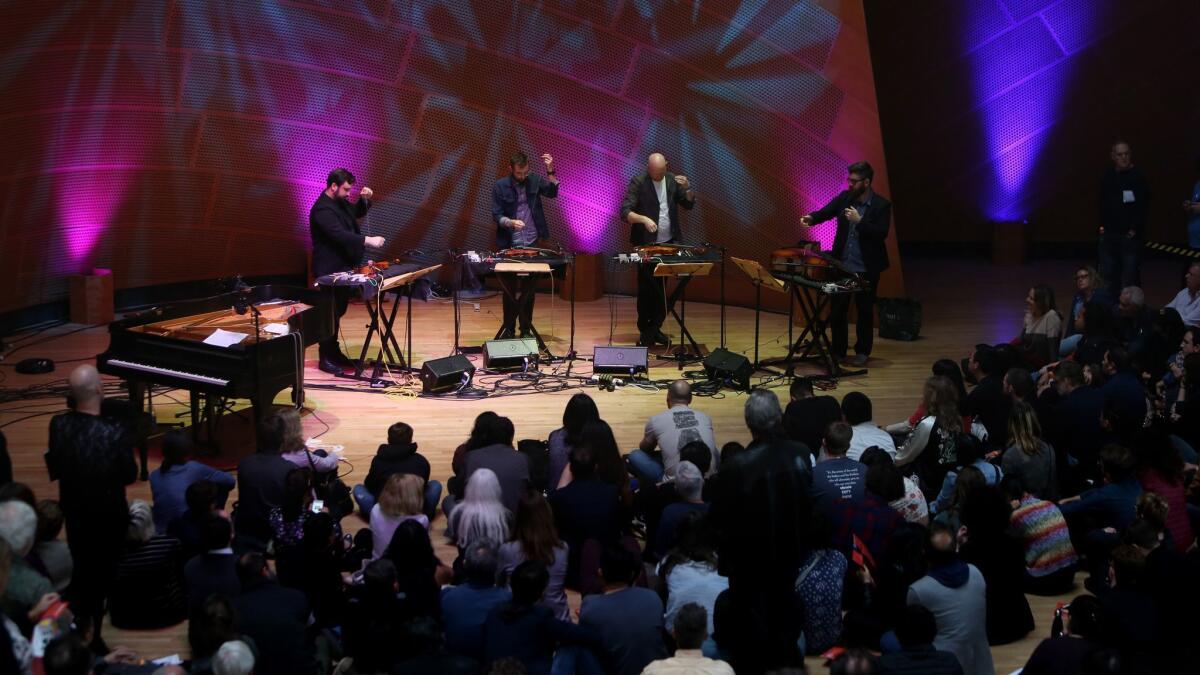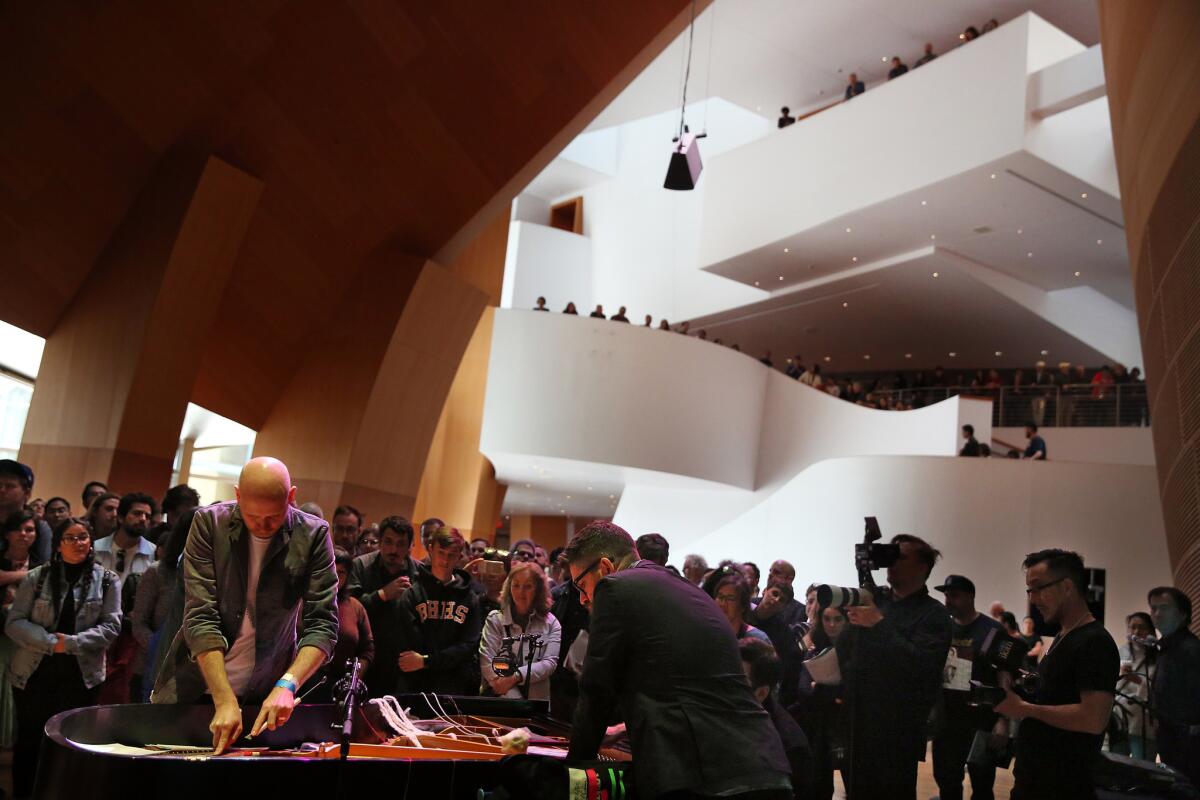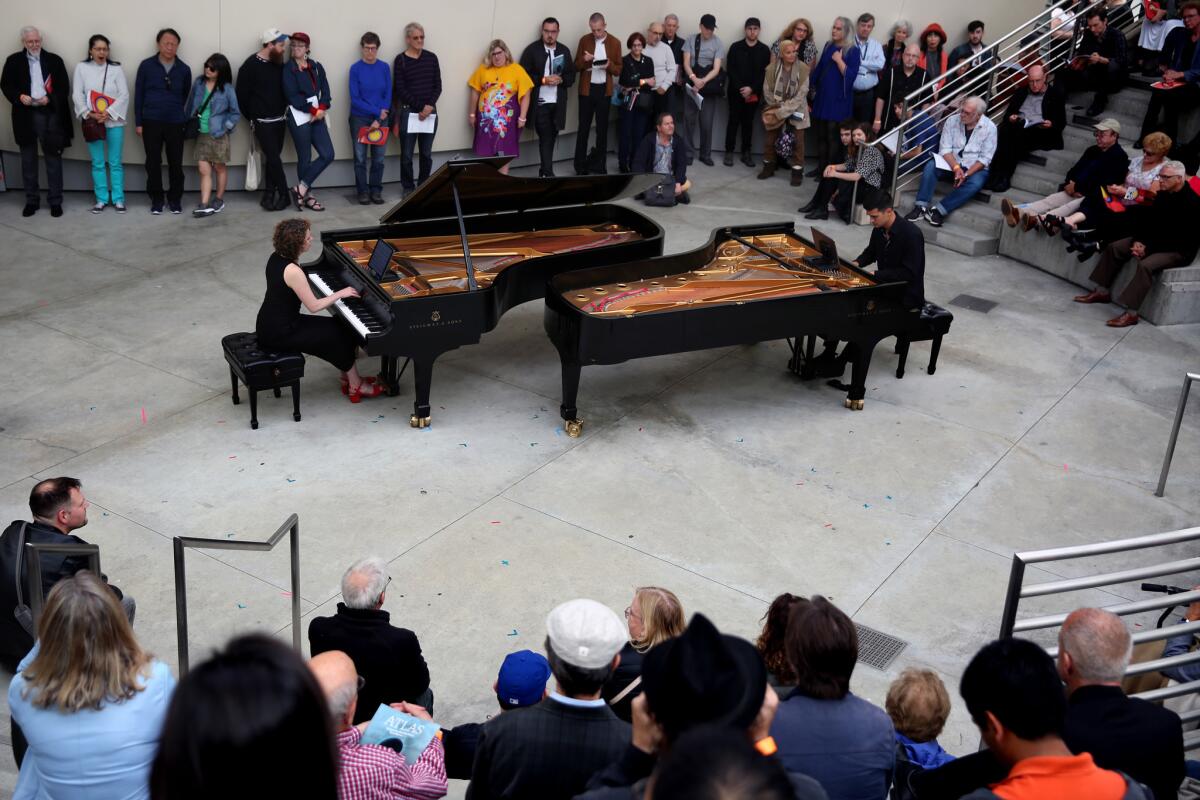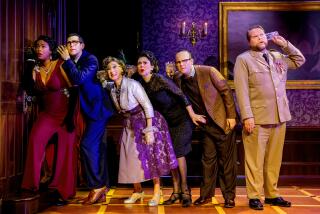Review: Why ‘Noon to Midnight’ is the new-music bargain that’s hard to beat

For $9 you could park all day under Walt Disney Concert Hall. For around $20 you got lunch from a food truck out front and a chance to snag one of the last cans of the Los Angeles Philharmonic’s rare centennial beer.
However, the real bargain Saturday was that $10 bought 12 hours of nonstop new music performed inside the main hall as well as in Disney’s various nooks and crannies and its outside staircase, garden and amphitheater.
This was the annual L.A. Phil “Noon to Midnight” new-music marathon. An impressive number of the top U.S. ensembles and feisty local ones participated. There were 24 newly commissioned works and pieces by more than 60 (I tired of counting) beginning, emerging, celebrated and legendary composers. The day included the L.A. Phil New Music Ensemble Green Umbrella concert of four big new pieces conducted by composer and “Noon to Midnight” mastermind John Adams — the one concert requiring a separate ticket. Anyone who made it to the end (or just wandered in off the street) got complimentary cake and ice cream.
Many performances took place simultaneously. Day and night became what you made of it — a new music sampler, your own playlist, a party (there was a beer garden). Like a museum show, you could check something out and move on at your own pace, a mixtape on the run.

It was an awesome logistical logjam for both attendee and an institution that has seemingly lost its sense. Such an event would requires weeks of planning and rehearsal, yet here it was centerpiece of the orchestra’s final weekend of the season, when it also was performing Mahler’s Eighth (“Symphony of a Thousand”), the single biggest thing any orchestra in its right mind mounts. Approximately a heroic third of the orchestra also participated in the Green Umbrella program, learning difficult new pieces.
The opening work was David Lang’s “crowd out” for a thousand voices. Inspired by a British soccer match, Lang’s score instructs the chorus (members of which came from ensembles of all sorts around the Southland) and the audience to shout their collective lungs out. For some, I was told, the text’s collection of anxiety-ridden phrases proved therapeutic.
But I escaped the collective aggressive by interpreting “crowd out” as a verb and headed for the amphitheater, where Ellen Reid’s colorful “Fear-Release” was exactly that, captivating in its gentle rustling, courtesy of the USC Thornton Percussion Group. Equally alluring was a fabulously colorful performance of Philip Glass’ “Glassworks” conducted by Jonathan Hepfer that followed in Disney’s BP Hall, the Monday Evening Concerts contribution.
BP is not an enclosed space, and it was packed with listeners crowding in. The ambient noise was substantial. One could not crowd out the intrusions, and suddenly the lesson of Lang’s piece became clear. Attention isn’t any one thing, so let the path through the new-music thicket be what it is.
Back inside the main auditorium, the International Contemporary Ensemble played the premieres of seven student composers who had participated in the L.A. Phil National Composers Intensive earlier in the week and who were given commissions. This was some of the most experimental music of not just the day but the season. No two pieces sounded remotely alike. The young composers tried out everything, from electronic craziness to evoking the brain righting itself in trauma. They held a listener’s attention with surprises and delights aplenty. Space is short, but the names of this class deserve mention: Rohan Chander, Camila Agosto, Nicholas Morrish, Kelley Sheehan, Salina Fisher, Nina Shekhar and Jessie Cox.
Meanwhile, in the lobby Calder Quartet had just finished a Timo Andres premiere, and the cellist Eric Byers and pianist Kevin Kwan Loucks were playing a quirky commission by Anders Hillborg.
For a while I found myself here and there. Toivo Tulev’s somber “I Heard the Voices of Children” sung by the outstanding choral group the Crossing and Pamela Z’s perky but also typical (for her) “Ways of Looking” played by Eighth Blackbird failed to break new ground. I headed back outdoors for John Cage’s “Two-2,” played by the piano duo Hocket.

It lasted an hour. The amphitheater was for part of that time standing room only. Chords, some consonant, some whatever the cat might have created walking on the keys, came and went, came and went, most quietly. The sounds of helicopters and laughter from the beer garden intruded. Yes, this was Cage; no, it wasn’t OK. But no matter. The pianists found an intimacy in the space, and the sounds they made brought enough pleasure.
After that, Ann Cleare’s “teeth of light, tongue of waves,” given its West Coast premiere indoors by ICE, proved especially gripping. It used a powerful Irish text sung in globular waves of vocal utterances by Alice Teyssier.
Two string quartets played by the Mivos Quartet stood out. In Jeffrey Mumford’s “… amid still and floating depths,” given its premiere in the Green Umbrella concert, sheets of individual string tones no doubt had structural reason, but for a first-time listener they evoked all kinds of noises, be they wind whipping through sails of ships at sea or animals in the forest reacting to an upset. This is music of adventure around the corner.
COMING UP: How Thomas Morris brought the Ojai Music Festival to the big time »
As the evening grew chilly, the Mivos moved to the garden for George Lewis’ masterful String Quartet 2.5 “Playing With Seeds.” The seeds are musical germs, Mivos tossing them around in a pageant of imaginative sonic circumstances. The full intent of Lewis’ invention was hard to hear outdoors. (Loudspeakers would have helped and given the neighbors a treat.) But the music was vivid enough to get noticed.
I, of course, missed more than I heard (and am leaving much out of what I did hear), yet that didn’t stop me from remaining put for the full 40-minute Southland Ensemble Anthony Braxton extravaganza. A walking bass beat underpinned a panoply of unexpected, jazz-inflected directions.
The night ended with Dylan Mattingly’s “Gravity and Grace,” a commission for Jacaranda Music, played by pianists Aron Kallay and Vicki Ray and organist Joanne Pearce Martin. (The latter two were back on the Disney stage 14 hours later for the Mahler.) This was a Minimalist chugging, chiming as brightly as Saint-Saëns — a kind of “Carnival of the Glassworks,” a sugar rush as enjoyable as the cake that followed.
By then the orchestra was out of ice cream. It was a big day, and no one could have it all.
MORE MARATHON MUSIC: Three minutes of ‘Marriage of Figaro,’ repeated for 12 hours straight »
More to Read
The biggest entertainment stories
Get our big stories about Hollywood, film, television, music, arts, culture and more right in your inbox as soon as they publish.
You may occasionally receive promotional content from the Los Angeles Times.











